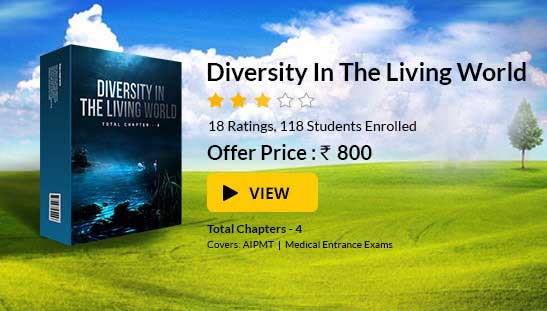Solutions
 (4) (4) Embryophyta includes all plants except thallophyta
(4) (4) Embryophyta includes all plants except thallophyta
(10) (2) Bentham and Hooker classified dicots into Polypetalae, gamopetalae and monochlamyqae.
(15) (4) The classification" of Linnaeus was mainly based on Stamens.
(25) (4) A.P. de Candolle first employed the characteristics of vascular tissue in taxonomy.
(35) (4) Whittaker placed prokaryotes and akaryotes in Monera.
(43) (3) Siphonogama includes Gymnosperm & angiosperm.
(49) (2) According to Whittaker kingdom monera includes Prokaryotes & akaryotes.
(53) (4) Engler & Prantl classified the Embryophyta on the basis of fertilization.
(63) (1). Fertilization by zoodiogamy occurs in Cryptogams.
(68) (1) Taxonomy based on all available information and attempting to classify organisms, according to their origin, evolution and variation is called classical taxonomy. A taxonomist engaged in studying origin, evolution, variation and classification of organisms is called classical taxonomist.
(69) (2) Hutchinson proposed phylogenetic classification of plants.
(70) (3) In five kingdom classification of Whittaker, eukaryotes were assigned to only four of the five kingdom. Prokaryotes are included in kingdom-monera.
(71) (4) The present day classification of living organisms is based on- anatomical and physiological characteristics
(72) (3) The term "phylum" in animal classification was coined by G.L. Cuvier.
(73) (4) Species living in different geographical areas are Allopatric species.
(74) (2) Identification is assigning on organism its correct name and placing it in its proper taxonomic category.
(75) (3) Sibling species: True species which do not interbreed but are otherwise difficult to separate on the basis of morphological characters alone.
(76) (4) A true species consists of a population is reproductivity isolated
(77) (3) Phenetic classification of organisms is based on observable characteristics of existing organisms
(78) (3) Barophillic prokaryotes grow and multiply in very deep marine sediments.
(79) (2) Systematics is related with classification of organisms. In classification the organisms are grouped on the basis of their characters or phylogeny, etc.
(80) (2) Acraniata includes marine forms without head or cranium. They lack jaws, vertebral column, paired appendages.
(81) (1) Anyone can study, describe, identify and give a name to an organism provide certain rules are followed. This rules are formed and standardised by International· Code of Botanical Nomenclature (ICBN) It uses articles, photographs and recommendations
(82) (1) Bacterial cell is prokaryotic. It lacks true nucleus, membrane bound organelles and sexual reproduction.
(83) (2) Bacteria have different shapes spherical, rod, and spiral are three important type. Cocci may be in cluster or chain form or Single and bacilli may be single, in pair in chain.
(84) (2) Bacteria utilize the wavelengths longer than 700 nm for photosynthesis and the reaction centre is P-890 the reductant is NADH + H+. In bacteria donor may be H2S or malate or succinate.
(85) (3) The Plasmodium often possesses a number of branched "veins". The protoplasm present in the veins show reversible streaming movement. The "veins" disappear and ·reappear as the Plasmodium moves -about
(86) (3) Leishmania donovani causes kala-azar. The parasite is transmitted by-sandfly. The parasite lives inside the cells of liver, spleen, lymph glands, white blood corpuscles and inner wall cells of blood capillaries. In sleeping sickness disease, the parasite damages the brain.
(87) (3) Mycorrhiza represents mutualistic symbiosis between fungus and roots of higher plants. Fungus helps in absorption of minerals. Water more efficiently and protect plant roots from infection. Fungus also gets food from plant.
(88) (3) Aflatoxins, are produced by Aspergillus flavus.
Contaminated food is the main source of infection. This toxin causes aflatoxicosis which may lead to haemorrhage and disease of liver.
To read more, Buy study materials of Biological Classification comprising study notes, revision notes, video lectures, previous year solved questions etc. Also browse for more study materials on Biology here.